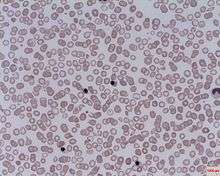Nucleated red blood cell
See also: Normoblast
A nucleated red blood cell, or NRBC, is a red blood cell (RBC) that retains nucleus. Normally, NRBCs are only found in the circulation of fetuses and newborn infants.[1] After infancy, RBCs normally only contain a nucleus during the very early stages of the cell's life, and the nucleus is ejected before the cell is released into the bloodstream. Thus, if NRBCs are seen on an adult's peripheral blood smear, it suggests that there is a very high demand for the bone marrow to produce RBCs, and immature RBCs are being released into circulation. Possible pathologic causes include anemia, myelofibrosis, thalassemia, miliary tuberculosis, cancers involving bone marrow, and in chronic hypoxemia.[2]

NRBCs are visible as larger cells with dark centers.
References
This article is issued from Wikipedia - version of the Thursday, December 24, 2015. The text is available under the Creative Commons Attribution/Share Alike but additional terms may apply for the media files.